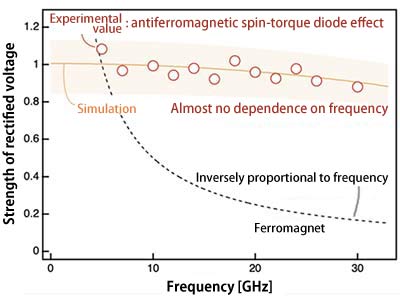Research Results
Toward the Realization of Ultra-fast Magnetic Devices for Next-Generation Telecommunication Infrastructures
New Spin-Torque Diode Effect Demonstrates Stability at High FrequenciesFY2025

- NAKATSUJI Satoru (Professor, School of Science, The University of Tokyo)
- JST-Mirai Program
- Program Manager (2020-2029), Large-scale Type: "Innovation of Photoelectric Technologies using Spintronics"
Discovery of New High-Frequency Spin-Torque Diode Effect Using Chiral Antiferromagnets
A research group led by Professor Satoru Nakatsuji at the School of Science, The University of Tokyo has been working on fundamental technologies that enable ultra-fast magnetic devices for next-generation telecommunications. To date, the research group has achieved significant results, including an ultra-fast, low-power magnetic shift register by harnessing the topological properties*2 of chiral antiferromagnets*1.
In this study, the research group uncovered usual spin-torque diode effect*3 in chiral antiferromagnets, which can stably operate at frequencies higher than that in conventional ferromagnets*4. The researchers reduced the thickness of a chiral antiferromagnetic manganese compound *5 to 10 nm or less (a nanometer is one-billionth of a meter). When they applied a microwave current (AC) to the material, a direct current (DC) voltage was observed (Fig. 1). The phenomenon in which an alternating current (AC) produces DC voltage is known as the diode effect; semiconductor-based rectifier diodes based on this effect are widely used. In contrast, the spin-torque diode effect utilizes the oscillation (precession) of the electron spin to achieve rectification, and this spin-driven mechanism produces function similar to the semiconductor diode.
Ferromagnet-based spin-torque diodes face a key limitation: the voltage signal strength rapidly decreases with increasing frequency, due to an inverse dependence on frequency. This limitation can be overcome by antiferromagnets, whose exchange interactions*6 lead to a much higher intrinsic energy scale compared to that of ferromagnets. Using spin-torque diodes based on chiral antiferromagnets, the research group demonstrated such a stable diode effect. The observed diode effect features stable signal with a strength approximately 10-100 times greater than that of ferromagnet-based counterparts, even at high frequencies. This newly discovered spin-torque diode has potential to drive the development of next-generation spintronics and high-speed communication technologies.

Fig.1
Schematic Diagram of the Experimental Setup (left) and the Rectified Voltage Signals Measured Using the Setup (right)
(Left) When a direct current and a microwave current are applied to a bilayer film composed of manganese alloy and tungsten, a lateral DC voltage is generated in response to the applied microwave.
(Right) Experimental data showing the rectified voltage signals. When the microwave is applied, voltage signals appear with a characteristic peak structure, and their amplitude is proportional to the microwave power.
*1 Antiferromagnet and chiral antiferromagnet
An antiferromagnet is a material in which the electron spins of neighboring atoms are aligned in the opposite directions. As a result, the magnetic moments of the spins cancel each other out, leading to nearly zero magnetization. Examples of antiferromagnets include manganese oxide and nickel oxide. In chiral antiferromagnets, the spins of neighboring atoms also point in different directions, but in a more complex pattern. Multiple spins interact with one another in a way that their magnetic moments still cancel each out macroscopically and produce negligible magnetization.
*2 Topological properties (of topological materials)
Topology is a field in mathematics that studies invariant properties of object under continuous deformation. A topological material is a material whose electronic state is characterized by topology, and such properties are called topological properties.
*3 Spin-torque diode effect
When a microwave current is applied to a magnetic tunnel junction comprising ferromagnet/insulator/ferromagnet, the alternating current (AC) voltage is converted into direct current (DC) voltage. This phenomenon is known as the spin-torque diode effect. It has the potential to surpass semiconductor diodes in terms of frequency tunability and sensitivity.
*4 Ferromagnet
A material in which the electron spins of atoms are aligned in the same direction, producing a sizable magnetization. This is the type of materials that stick to magnets. Examples of ferromagnets include iron, cobalt, and nickel.
*5 Manganese compound
The manganese compound used in this study (manganese-tin alloy: Mn3Sn) features manganese atoms arranged in a kagome lattice structure, with each atom’s magnetic moment oriented at 120-degree angles relative to its neighbors. Although this manganese shows nearly zero net magnetization, its external field response is as large as that of ferromagnets.
*6 Exchange interaction
The energy that drives parallel or anti-parallel alignment of spins of neighboring atoms.
Foundational technology for next-generation ultra-fast magnetic devices
In recent years, our society is becoming increasingly IT-oriented with the rise of internet usage, calling for new devices that can process the rapidly increasing flow of information with low power consumption. To date, electronics have been centered around semiconductors, leveraging the electrical properties of electrons. On the other hand, spintronics focus on the magnetic property of electrons known as electron spin, and it has been actively investigated in recent years. One remarkable progress in this field is the implementation of magnetoresistive random access memory (MRAM) using ferromagnets as a nonvolatile memory that does not require power for data retention. The use of antiferromagnets for MRAM draws significant attention as a next-generation technology. This approach is expected to greatly enhance the speed and density of MRAM.
Conventional spintronics focuses on ferromagnets, which exhibit large responses to electric currents and light that relate directly to their sizable magnetization. For instance, it is well-known that applying a microwave current to a magnetic tunnel junction*7, in which ferromagnets sandwich insulators, results in the spin-torque diode effect that generates a DC voltage. However, the use of ferromagnets presents a challenge: the diode signal strength sharply decreases with increasing frequency.
*7 Magnetic tunnel junction
A structure with a thin insulating layer sandwiched between two magnetic layers. Whether the direction of the spins in the magnetic layer is the same or opposite affects how easily electrons can pass through the insulating layer, resulting in a significant change in electrical resistance. Using such property, the magnetic tunnel junction is applied in magnetic memory and magnetic field sensors.
Emergence of high-frequency spin-torque diode effect in antiferromagnet-based devices
The research group focused on antiferromagnets to avoid the diode signal attenuation at high frequencies, Since the energy scale of the exchange interaction in antiferromagnets is high, antiferromagnets demonstrate a much larger resonance frequency than ferromagnets and are anticipated to show stable diode operation even at high frequencies. On the other hand, the issue in antiferromagnets is the difficulty to gain large responses similar to ferromagnets due to their vanishingly small magnetization.
This study focuses on a manganese-tin alloy (Mn3Sn), a chiral antiferromagnet. This material demonstrates ferromagnet-like responses despite being an antiferromagnet due to its unique (topological) electronic band structure. Thus, it has recently been attracting attention in various fields such as low-power nonvolatile memory, photoelectric fusion, and thermoelectric conversion sensors. The research group first created a manganese-tin alloy thin film on top of a tungsten thin film and reduced the thickness to 7 nm. When an electric current is applied to this bilayer film, the current is converted into a spin current (the flow of spins), in the tungsten layer and flows into the manganese-tin alloy, resulting in spin motion. Next, the research group made devices from the produced thin films and performed an experiment where a 5 GHz microwave current and a DC current were applied to the device simultaneously while applying a magnetic field. Then, the team detected a DC voltage with a characteristic peak structure proportional to power appeared according to the application of microwave current (Fig. 1, right). This result indicates that the spin-torque diode effect also manifested itself in devices made of antiferromagnets. Further, the research group performed experiments where the frequency of the applied microwaves was changed up to 30 GHz, demonstrating that the magnitude of the peaks varied little in this range (Fig. 2). This behavior is essentially different from the decrease in diode signals in ferromagnets that is inversely proportional to frequency.
To understand this behavior, the research group performed detailed numerical simulations, taking into account the exchange interactions of antiferromagnets. The simulations remarkably reproduced the experimental results, showing that when the spin motion driven by the DC current is suppressed by the magnetic field, it efficiently interacts with the microwaves and consequently produces a rectifying effect. This finding revealed that the stable behavior in response to frequency observed in the experiments arises from strong exchange interactions.

Fig.2 Difference in Diode Effect Between Antiferromagnets and Ferromagnets
Toward the realization of Beyond 5G ultra-fast magnetic devices
The research results verified the spin-torque diode effect, which converts high-frequency current into DC voltage, in antiferromagnets for the first time. The use of antiferromagnets enables the spin-torque diode effect appearing in an unprecedentedly wide frequency range. As a result, spin-torque diodes will likely be applied in high frequency ranges of up to terahertz (THz) and may contribute to the advancement of next-generation spintronics and Beyond 5G*8, which is the next-generation communications technology. Further, the manganese-tin alloy used in the research is also expected to be applied to low power consuming and fast-operating nonvolatile memory and photoelectric conversion elements due to its topological electronic structure and is anticipated to contribute to resolving the problem of increasing power consumption due to use of AI and various kinds of electric data.
*8 Beyond 5G
The next generation telecommunication infrastructure (6G) following 5G which will be implemented in the 2030s.
